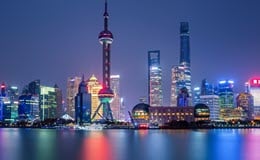Is China Tanking?
Chinese equities have been soft and President Trump is threatening a trade war, but earnings and margins remain firm and China is still the world's best consumer story.
"Chinese equities may be soft, but industrial earnings and margins remain firm, and China is still the world’s best consumer story."
Chinese equities have been soft and President Trump is threatening a trade war, leading to some jitters about the state of the economy. But new macro data for the second quarter reflect that economic fundamentals and corporate earnings in China remain strong.
In this issue of Sinology, I focus on the health of the largest part of the Chinese economy: domestic demand. I will also explain why even a trade war would have only a modest impact on China.
Equities Soft But Earnings Firm
The Shanghai Composite Index may be down 14% year-to-date through July 13, but profit growth for larger industrial firms (including many not listed on a stock exchange) remains very healthy.
Industrial profits rose 21.1% year-over-year (YoY) in May, the most recent data available, compared to 16.7% a year ago. For the first five months of the year, industrial profits rose 16.5%. That was 1.5 percentage points faster than during the first four months of this year but down from 22.7% during the first five months of 2017. This slower (but still quite strong) earnings growth rate was expected due to the tough base from last year. To put this in perspective, during the first five months of 2016, profits rose 6.4%, and during that period in 2015 profits declined slightly.
Industrial margins in the first five months of this year are at the highest levels in eight years for the same period, and margin expansion continued in May.
Industrial value-added rose 6% in June (vs. 7.6% a year ago) and 6.6% for 2Q (vs. 6.9% in 2Q17), signaling a healthy manufacturing sector.
Still the World's Best Consumer Story
The rebalancing of the Chinese economy continued, and in the first half of 2018, consumption accounted for 78.5% of GDP growth (up from 45.2% in 1H13).
As we've pointed out many times in the past, this great consumer story is not immune from the trend of decelerating economic growth. Inflation-adjusted (real) retail sales rose 7.2% during the second quarter, down from 9.7% in 2Q17 and 9.8% in 2Q16. This is still a very fast pace, and the base effect is worth noting. For example, 9% real retail sales growth for the full year of 2017 generated an incremental expansion in consumer spending that was 135% larger than the increase resulting from 12.4% growth in 2007. In other words, the opportunity for selling goods and services to Chinese at the slower growth rate is far larger than the opportunity 10 years ago, at the faster growth rate.
Second quarter real retail sales were unexpectedly soft, but for a clear, short-term reason. In April, Xi Jinping announced that tariffs for imported autos would be reduced in July, so consumers postponed purchases with the expectation that prices for cars (including those made in China) would come down. Auto sales, a significant component of overall retail sales, declined 9% YoY in 2Q18, in contrast to an increase of 8% during that period last year. I expect auto sales to rebound in late July, after the conclusion of the World Cup, which was broadcast during evenings in China and likely kept many car buyers in their neighborhood pub.
New home sales rose 3.6% (on a square meter-basis) during the second quarter. This is impressive given that it comes off a very high base—sales were up 11.4% during the same period last year—and also because more than 100 cities have implemented purchase restrictions designed to cool the market. And these sales involve a lot of cash: the minimum down payment is 20% of the purchase price and most banks require 30% cash.
The consumer story continued to be supported by strong real income growth (6.6% YoY in 1H18, vs. 7.3% in 1H17), mild consumer price inflation (1.9% in June), high household savings and low household debt.
Consumer spending in the coming quarters should also be boosted by a few recent policy changes. Most importantly, the government revised the requirements for personal income tax, which will deliver tax cuts to most workers. On a relative basis, the biggest cuts will go to those earning less than the equivalent of US$100,000 per year, which should stimulate demand as lower-income families have a higher marginal propensity to consume.
An Infrastructure Pause
One data point that has worried some analysts is weak growth in headline fixed asset investment (FAI). For the first half of the year, FAI rose 6%, down from 8.6% in 1H17 and 9% in 1H16.
While I expected FAI growth to continue to decelerate—because of the large base and the rebalancing of the economy away from dependence on capital-intensive manufacturing and toward services and consumption—the slowdown of the last couple of months was sharper than expected, due to a central government effort to better regulate local government spending on infrastructure.
I estimate that infrastructure investment rose by about 2% YoY in both May and June, and for the first half of the year, infrastructure spending rose 7.3%, compared to 21.1% in 1H17. As the regulatory review concludes, I expect a modest recovery in infrastructure spending, which accounts for about 22% of total FAI, in 2H18.
It is important to note that the two other major categories of FAI remain healthy. Manufacturing capital expediture, which accounts for about 31% of total FAI, rose 6.8% in the first half of the year, up from 5.5% during 1H17.
Investment by privately owned (as opposed to state-owned) firms is also strong, up 8.4% in the first half compared to 7.2% during 1H17.
Investment in real estate, which accounts for about 22% of total FAI, is healthy, up 7.7% during the first five months of the year, compared to 6.1% during the same period last year.
De-risking Has Tightened Credit Availability
Over the past year, we've discussed the government's aggressive efforts to de-risk the financial system, including a crackdown on non-standard (shadow banking) sources of credit. New issuance of bank wealth management products, for example, has been sharply curtailed.
This has meant that although the growth rate of aggregate credit has slowed gradually, in line with slightly slower nominal GDP growth, the composition of credit has changed dramatically. Five years ago, traditional bank lending accounted for about 51% of total credit, with the balance coming from non-standard sources such as trust and entrusted loans. This year, however, bank lending accounts for more than 90% of total credit.
This has reduced systemic risks, but it has meant that the firms that relied on non-standard credit sources, especially small- and medium-sized private companies, have struggled to get access to credit.
In recent days, the central bank has acknowledged that this small-business credit squeeze is a problem and has postponed implementation of further de-risking measures. In the coming months I expect regulators to take additional steps to improve access to credit by smaller firms.
At Matthews Asia, we are focused on Chinese companies selling goods and services to Chinese consumers, so the impact of a trade war on our strategies should be modest.
Trump Tariff Rumble
The July 2 issue of Sinology provided a detailed discussion of the impact of the Trump tariffs, so I will just offer an update here. Trump has pledged another round of tariffs on US$200 billion of Chinese imports, but because the tax rate will only be 10%, I do not expect it to have a significant impact on Chinese shipments. My assumption is that in the majority of cases, U.S. importers will continue to source these goods from China, with some of the 10% tax passed on to consumers and the rest absorbed as lower margins for U.S. importers and producers of final goods.
I still think there is a high probability that Xi Jinping will follow the non-confrontational path I described in the last Sinology, leading to negotiations with Trump which will resolve the bilateral dispute in the fall.
But, if I'm wrong, and the tariff dispute escalates into a real trade war, there are a few key points to keep in mind. First, the Chinese economy is no longer export-driven, so the impact of a trade war will be modest. Net exports (the value of a country's exports minus the value of its imports) account for only 2% of China's GDP, down from a peak of 9% in 2007. In contrast, domestic consumption now accounts for the majority of China's economic growth and more than half of its GDP.
Second, because Trump would be fighting a trade war without the support of America's allies, the impact on China's exports would be relatively small. Last year, Chinese exports to the U.S. accounted for only 19% of total Chinese exports.
Third, on a micro-level, I believe much of the impact of Trump's import taxes will not be borne by Chinese companies; about two-thirds of the 25 largest exporting companies based in China are foreign-owned. It is also clear that the Xi's government will step in to provide financial aid to any Chinese companies that are hurt by the Trump tariffs. With central government fiscal revenue up 15% YoY during the first five months of the year—the fastest growth rate in four years— Beijing has the resources, as well as the political will, to support domestic firms, just as it did a decade ago during the Global Financial Crisis. As a result, I do not believe a trade war would cause significant damage to the Chinese economy.
And, at Matthews Asia, we are focused on Chinese companies selling goods and services to Chinese consumers—the largest and fastest growing part of the economy. The impact of a trade war on earnings growth of these companies should be modest. Across all of our strategies, less than 5% of our China holdings have significant exposure (greater than 15% of total revenue) to the U.S. market. The impact of a trade war on our strategies should be modest.
Andy Rothman
Investment Strategist
Matthews Asia



